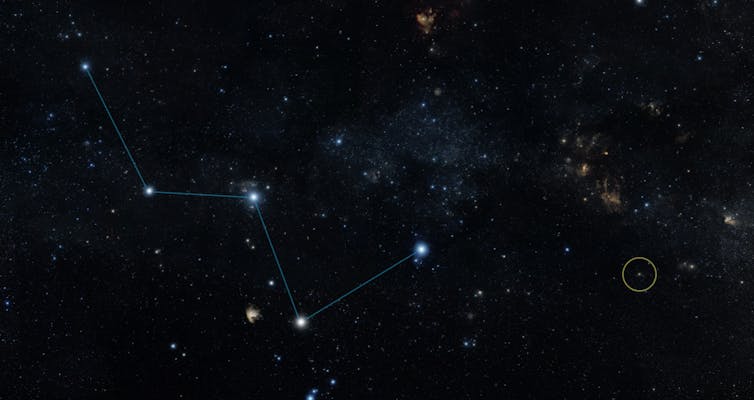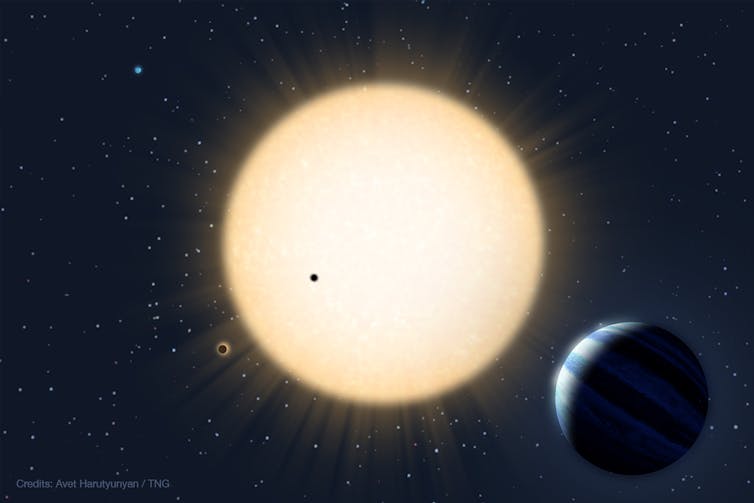The recent discovery of Earth-like exoplanet Kepler 452-b has caught people’s imagination, with some calling it “Earth 2.0”. But this has led to another new, potentially far more important exoplanet’s discovery going unnoticed. While it may not have a catchy name, HD 219134 b, the nearest known rocky planet outside our solar system, deserves our attention too.
The planet (“b”) orbits its star HD 219134, which is visible to the human eye near the constellation Cassiopeia, only 21 light-years from the sun. The planet orbits its star alongside three others – like our solar system with Mercury, Venus, Earth and Mars, HD 219134 b has planetary siblings.

What makes HD 219134 b special is how near it is to us – relatively speaking. We can learn a lot about exoplanets like this with techniques that would be difficult or impossible for those at greater distances.
For example, using a technique called the radial velocity method it’s possible to deduce an exoplanet’s mass by measuring tiny movements of the star caused by the exoplanet’s gravitational pull. This reveals that HD 219134 b has a mass of between four and five times that of the Earth, making it a type of exoplanet known as a “super Earth”.
We can learn more about exoplanets when their orbit takes them between their host star and us. This blocks some of the starlight during the transit, which reveals the planet’s diameter. HD 219134 b is just 1.6 times bigger than the Earth, which together with the measured planetary mass establishes that the planet has the density of rock.
In contrast Kepler 452-b’s mass hasn’t been measured, so it’s not known whether the purported “Earth 2.0” is really a rocky planet at all, although similar-sized planets with measured masses are generally rocky. The fact is, at a distance of 1,400 light years it’s very difficult to measure anything using radial velocity methods.
Getting to know our neighbour
So HD 219134 b is now both the nearest known rocky planet and, more importantly, the nearest known planet that transits in front of its star. This kind of planet is particularly exciting for astronomers. If it has an atmosphere, then its nature can be revealed when starlight passes through it during transit.
The atoms and ions making up the atmosphere each absorb starlight at their own characteristic pattern of wavelengths. These tiny amounts of extra absorption can be detected, allowing us to measure the atmosphere’s composition. This is important: it reveals details about processes like volcanism on the planet surface, tells us something of how the planet has evolved, and the atmosphere determines the planet’s surface temperature.
Space telescopes, such as the Hubble Space Telescope and the proposed Twinkle mission, can take these measurements. But the accuracy is limited by the amount of light we collect. Give an astronomer a choice between two similar stars at very different distances from the sun, they will always choose the nearer. A factor of 10 increase in distance means 99% less light, and this is precisely why finding such a nearby transiting planet is a big deal.

What about Earth 2.0?
The search for exo-Earths has moved on, from science fiction to just science. To place ourselves, our planet and our solar system in their proper galactic and universal context by studying other examples can answer questions which have probably existed since human consciousness arose.
Kepler 452-b has an important place in this new science of comparative planetology, as one of the first convincing candidates for an Earth-like planet. But it’s just a candidate: there is a lot about Kepler 452-b that we can’t be sure about, as it’s just too far away. On the other hand the relative proximity of HD 219134 b, though it orbits very close to its host star and so is far too hot for liquid water to exist on the surface, provides us better opportunities to unlock its secrets.
One of the most important things the Kepler observatory has revealed is that small rocky planets appear to be plentiful. This makes it a statistical near-certainty that there are Earth-like planets much closer to us than Kepler 452-b – we just haven’t found them yet. Meanwhile, planets around bright, nearby stars such as HD 219134 constitute one of the most exciting areas of astronomy.
HD 219134 b will teach us much in the next few years about the formation and evolution of a neighbouring planetary system, and this will begin the scientific journey that will ultimately place our own solar system in the wider story of planet formation throughout the Milky Way galaxy.

